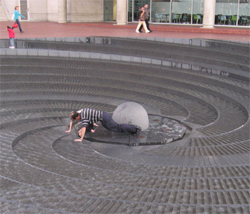Creative Thinking Hacks
 All of us possess everything necessary to be more creative. The problem is we’ve been trained away from our creative instincts by schools, parents, movies and workplaces. The word creativity is frequently inflated by association, frequently appearing with overused, hype-laden words such as genius, brilliance, revolution and innovation. Hype mongers and creative intimidators throw those labels around like candy, scaring most people out of their own natural creative instincts.
All of us possess everything necessary to be more creative. The problem is we’ve been trained away from our creative instincts by schools, parents, movies and workplaces. The word creativity is frequently inflated by association, frequently appearing with overused, hype-laden words such as genius, brilliance, revolution and innovation. Hype mongers and creative intimidators throw those labels around like candy, scaring most people out of their own natural creative instincts.
This essay, a high speed hack-centric interpretation of the creative thinking course I taught at the University of Washington, offers both concepts and tricks to help anyone be creative at any time.
If you don’t want to read, you can watch the presentation:
Kill creative romance
First, like most media today, this essay starts with violence (and unnecessary exclamation points)! Close your eyes, imagine the most amazing sword ever made, and attack every creative legend you’ve ever heard. We’ve romanced da Vinci, Mozart and Einstein into gods, minimizing the ordinary aspects of their lives so intensely that their mothers wouldn’t recognize them in the legends we tell. Next, using your sword’s mint scented flamethrower attachment, set fire to childhood tales of Isaac Newton and the apple, Benjamin Franklin and the lightning kite, and Edison and the light bulb. These popular tales of creativity and discovery are deceptive at best, wild lies at worst, shaped to placate the masses, not to inform creative people on their craft. Tear it all down, throw a dozen napalm coated hand grenades in for good measure, and watch your old, broken down view of creativity go up in flames. Dance over the smoldering ruins! Roast marshmallows on the still warm remains of your creative fulminations! The fun begins now.

On the new creative landscape you’ve made, place the following simple definition: an idea is a combination of other ideas. Say it five times out loud. Say it to your cat. Yell it out you car window at strangers waiting for the bus. Every amazing creative thing you’ve ever seen, or idea you’ve ever heard can be broken down into smaller ideas that existed before. An automobile? An engine + wheels. A telephone? Electricity and sound. Reese’s peanut butter cups? Peanut butter and chocolate. All great creative ideas, inventions, and theories are comprised of other ideas. Why should you care? Here’s why: if you want to be a creator instead of a mere consumer you must see ideas currently in the world as fuel for your mind. You must stop seeing them as objects or functional things: they are combinations of ingredients waiting for reuse.
Combinations
Cooking is a brilliant analogy for creativity: a chef’s talents hinge on their ability to bring ingredients together to create things. Even the most inspired chef in history did not make bacon appear by mere concentration, nor suggest to the divine forces that a ripe tomato would be a “nice to have” on the list on desired outcomes of evolution. Buying into the “creativity as combinations” view of the world, helps creators in many ways. It means that if at any time you feel uncreative the solution is to look more carefully for the combinations available to you. Increasing creativeness at any time doesn’t require anything more than an increase in your observations: become more open to the possible combinations of things than you currently are.
Here’s a test: quickly pick two things in front of you, say this web browser and your annoying, smelly friend Rupert. Now close your eyes and imagine different ways to combine them.
If you’re stuck, here are three:
- Rupert with a minimize button
- An annoying, smelly web browser
- Web browsing on, or with, Rupert’s face
Now while these combos might not be useful, good, or even practical, they’re certainly creative. Adding a third element, say a gallon of jolt cola, might yield even more interesting combinations (a caffeine overdosed smelly web browser infused with Rupert’s annoying personality).
Over time, creative masters learn reusable combinations, or patterns, that can be used again and again to develop new ideas or modify old ones. Study any creative field, from comedy, to cooking, to writing to music composition, and you’ll discover patterns for constructing good combinations that appear again and again.
(Snark resistant disclaimer: Yes, there are other complexities to working with ideas that the combinations themselves don’t solve. And yes, I confess that sheer combinations of ideas won’t necessarily yield brilliance. But you get what you paid for: read the title of this free essay again – it’s creative thinking, not brilliant thinking. So go snark elsewhere).
Inhibition
We’re afraid. We’re afraid of the dark, of our parents, and what our parents do in the dark. Our tiny, efficient brains do their best to keep us from thinking about things we fear or don’t understand. This is good for survival, but bad for combination making. We shut down the pursuit of many combinations because of predictions we make about what the result will be like. Remember this: we suck at prediction. Half the challenge of being creative is turning fears off, and trying out ideas even if we think they might not work or are unsure of what will happen. Weird ideas almost always teach us something we could not have learned any other way, and improve the chances the next combo will be more useful.
One way to think of creative people is that they’re the ones who have more control over their fears, or simply have less fear of embarrassment. Being creative has more to do with being fearless than intelligent, brilliant or any other adjective superficially associated with creativity. This explains why many people feel more creative when drinking, on other drugs, or late at night: these are all moments when our inhibitions are lower, or at least altered, and we allow ourselves to see more combinations of things than we do at other times.
Environment

Creativity is personal. No book (or essay) can dictate for you how to be more creative. You have to spend time paying attention to yourself: when do ideas come easiest to you? Are you alone? With friends? In bars? At the beach? Are there times of day when you’re most relaxed? Is there music playing? Start paying attention to your own creative rhythms and construct your creative activities around them. To get all Emersonian on you, this is called self-knowledge: you can’t be productive as a creator if you’re not paying attention to your own behavior and learning about how best to cultivate the idiosyncratic and custom wonder that is you.
Persistence
Being creative for kicks is easy. But if you want to be creative on demand you must develop habits that help and that’s about persistence. You won’t always find interesting combinations for a problem right away, and identifying fears and working through them is rarely fun. At some point all creative work becomes, simply, work. Study the histories of great creators and you’ll find a common core of willpower and commitment as their driving force. Van Gogh, Michelangelo and Mozart worked every day. Edison, Hemingway, Beethoven, and most legendary talents outworked their peers. Forget brilliance or genetics, the biggest difference between the greats and us, was their dedication to their craft.
The greatest creative hack, however unglamorous and obvious it might be, is simply not giving up. Playing with ideas is one thing, but realizing them in the world is another. When an idea is fully formed in your head there’s no escaping the fact that for the idea to change the world it has to leave your brain, a journey that only happens with ordinary, regular, ever-day hard work. Writing proposals, sketching designs, pitching ideas: it’s all work most of us know how to do. The question is how far are you willing to go to make your idea real: a challenge that has little to do with creative thinking.
Also see: How To Save Your Creative Soul – a TEDx talk on persistence.
Creative thinking hacks
Just so you know, I know that you skipped the rest of the essay and jumped straight down here.
- Start an idea journal. The rule is: any idea that pops in your mind, at any time, write it down. There are no inhibitions: any idea for anything goes in here. This will help you find your own creative rhythms, as over time you can note what times of day you’re more creative. I recommend a paper journal, so you sketch or draw things, but digital journals can work too. Whenever you’re stuck, flip through your journal. You are bound to find an old idea you’ve forgotten about that can be used towards the problem you’re trying to solve.
- Give your subconscious a chance. The reason ideas come to you in the shower is that you’re relaxed enough for your subconscious to surface ideas for you. Make this easier: find time to turn your mind off. Go for a run, swim, jog, have sex, something that’s as far from your creative problem as possible.
- Inversion. If you’re stuck, come up for ideas for the opposite of what you want. If your goal was to design the best album cover ever, switch to designing the worst album cover ever. Five minutes at an inverted problem will get your frustrations out, make you laugh, and likely get you past you fears. Odds are high you’ll hit something so horribly bad that it’s almost good, and you’re inspired to switch back to your original goal.
- Switch modes. Everyone has dominate ways to express ideas: sketching, writing, talking. If you switch the mode you’re working in, different ideas are easier to find and your understanding of a particular idea changes every time you use a different medium to express it. This is both a way to find new ideas, and to explore an idea you’re focusing on.
- Take an improvisational comedy class. This will be easier and less painful than you think. It will teach you an entirely new way of thinking about the craft of creation. Most improve classes are structured around fun, party type games and teach you ways to combine ideas in real time: a powerful skill for any creator (If you’re unconvinced, read What I Learned From Improv Class).
- Find a partner. Many people are most creative when they’re with other creative people they like. Partnering up on a project, or even being around other creative people who are working on solo projects, keeps energy levels high. It also gives you a drinking buddy when things go sour.
- Stop reading and start doing. The word create is a verb. Be active. Go make things. Don’t study it like accounting: you have to go do it, and make lots of mistakes, to learn anything about your own creative process. So get off the web and start making something.
Have your own creative thinking hacks to share? Leave ’em here.

i liked your essays i did at times used such kind of things that you mentioned.i feel you are a good motivator and a conversationalist.
Similar, but different advice: http://www.gomediazine.com/design-tip/10-tips-avoid-designers-block/
Just stumbled on your website while looking at ROWE for best buy. I’m impressed with your views on creativity and measurement of progress.
Sincerely
Derrick
I read about your website on my friend’s blog.I must say this is an excellent article and an eye opener for many out there.Very motivating!Keep posting more!
Thankyou this has answered many questions (old& new) and made me look at the cold facts of what I want to do. I am now ready to go back to my blank page and with the tools you have given to me, put somthing,anything on it. Thats my start.
Scott – great points here. Especially that creativity is a personal process. There are plenty of theories of creativity floating about, and the one that I most relate to is the quote from Albert Szent-Gyorgyi:
“Discovery is seeing what everybody else has seen, and thinking what nobody else has thought”.
I think creativity is very much a personal discovery process. Like you said, there is no “best” way to do this. Only the “best” way for you.
Keep up the great work!
Hi Scott,
Thanks for the great insights and advice. Sincerely, you’re one of my heroes who keeps on giving.
Scott, I am in the process of making creative changes in my life. your writes are uplifting and simple,which makes reading your work easy on the mind.
I found your thoughts on persistence especially informative and I plan to remember -“Playing with ideas is one thing, but realizing them in the world is another. When an idea is fully formed in your head there
Hi Scott,
Three comments
1. You are right about creativity
2. Poincare and Robert Persig have lots to say.
3. I have found learning to improvise jazz by ear has sped up my creativity in other areas. I use musical instruments as an alternative media to tap into and improve creativity. I put musical ideas together in new ways
A pearl for you
-Pirsig said Quality is at the centre of thought connecting art and science. He was right.
-Duran said “Quality is fitness for use”. He also was right.
Put these together and discover that “USE” (which I prefer to call “PURPOSE” is at the centre of all thought.
We humans create purpose. Purpose contains but transcends subject and object.
The argument between creationism and Darwinism remains but can be better understood as debate about the non existence of fundamental purpose.
Chris Caudwell
Love your style of writing. Everything is very simply put. I like the touch of humor in your essays. They put a smile on my face. They are highly motivating as well. Keep up the good work.
I like your suggestions for creative thinking. Sometimes I run into a writers block, so this article is very helpful. For certain I need to be more active and do things more. If I do this, I feel that I will be able to write with more pep and phizaz.
dude u r just 4wes0me.luv u!
persistence is what i’m lacking most. i’ve studied poetry, and there was an elegy “for every thing there is eagerness, and for every eagerness there is a weakening”this essay helped, A LOT
ps:i luv every1 ever born :*
I love stumbling on old posts like this, and finding them relevant. Your article summarizes a lot of the info. in my typical presentation that helps adults tap back into their innate creative abilities. We need to let go of adult inhibition about creativity for sure. Good post, and evidently, timeless…
Inversion is a truly mighty trick — thanks for the heads up. I guess the power might come from actually letting us drop the inhibition for a second, to let us concentrate on the problem rather than our worries about not being able to solve it.
Thanks again, Scott.
I find all the creativity I need while walking. It’s strange, but I believe there are a lot of philosophers and thinkers throughout history who have agreed with the idea that walking somehow stimulates creativity and thought.
Tanks for this post. I agree we have all been trained away from our innate creative abilities. I think that is what causes so much of the unhappiness in this world, and learning to reconnect with that part of ourselves has massive positive impacts on our lives!